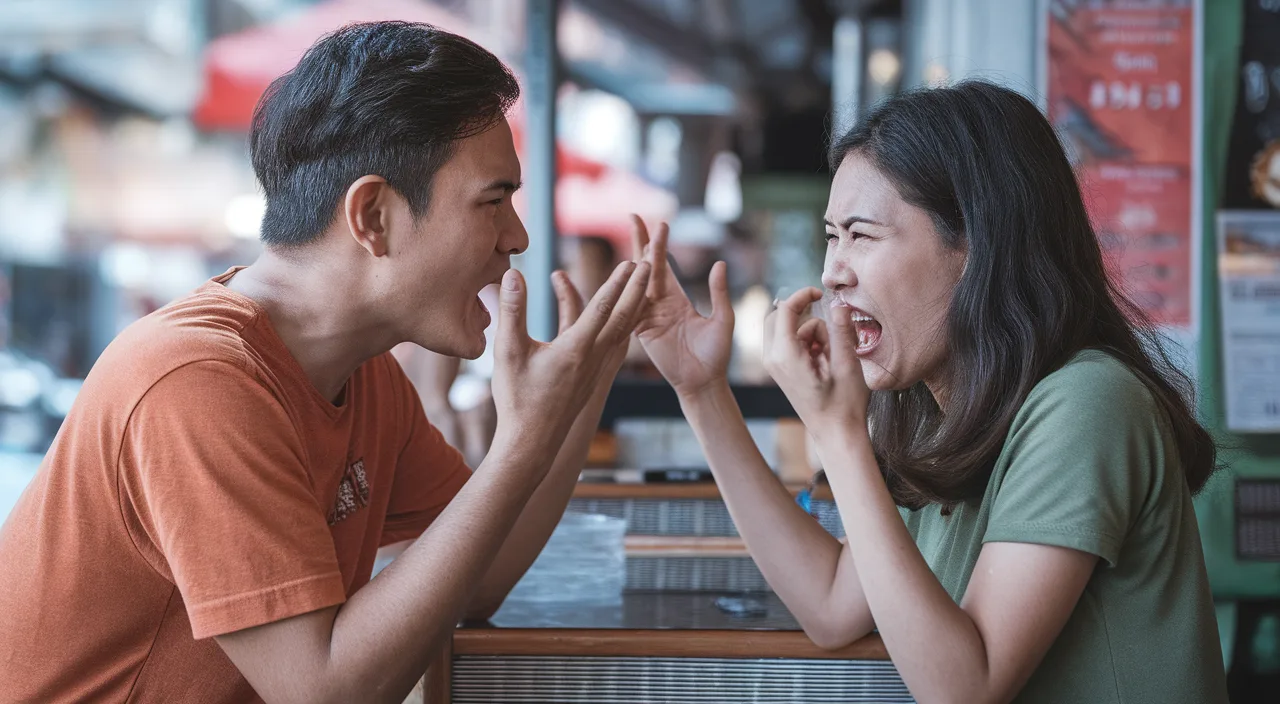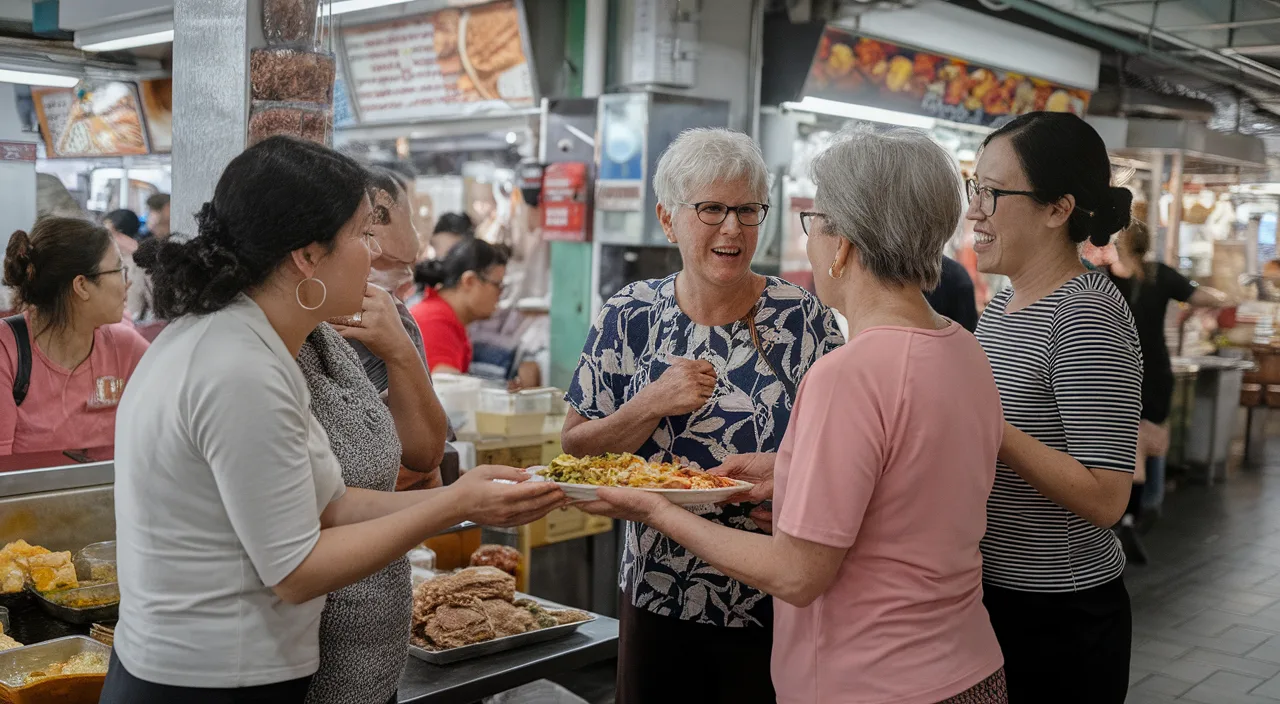What does ‘Kick your backside’ really mean in a Singaporean Argument?
Short answer: It’s *not* a violent threat lah. It’s peak Singlish — a colourful, mildly threatening but fully affectionate way to tell someone they’re being nonsense. Think of it like a verbal flick on the head — common in family scoldings, work banter, and friend group drama all over Singapore. The real goal? To scold without scolding. To argue without fighting. To settle without saying sorry. Power, right?
TL;DR
- ‘Kick your backside’ is a uniquely Singaporean Singlish phrase used in a variety of arguments — light-hearted or more serious.
- It’s culturally rich, emotionally expressive, and often pops up in conflicts at home, coffee shops, NS camps, schools, even hawker centre table wars.
- The phrase blends humour + mild warning + local flair — the perfect local tool to diffuse tension.
- Understanding how it’s used helps you read the room more accurately during conflicts in Singapore’s multicultural, multilingual society.
- We’ll also cover common arguments in Singapore and how to resolve disagreements the Singlish way — without making it worse.
Understanding Singlish in Singaporean Arguments
A Brief Introduction to Singlish
For the uninitiated: Singlish isn’t just English spoken with a Singaporean accent — it’s a beast of its own. Born from Hokkien, Malay, Tamil, and English influences all rolled into one linguistic prata, Singlish is expressive, versatile, and very context-driven. Perfect for Singaporean arguments, where subtlety and humour often do a better job than confrontation.
Singlish phrases like “kick your backside,” “don’t play play,” or “you wait long long” carry weight because they are laced with cultural undertones. You know when your mother says, “eh, you want me kick your backside or not?” – she’s not gonna roundhouse you Jean-Claude Van Damme style, but you’ll feel the emotional impact right in your paiseh soul.
Why ‘Kick your backside’ Solves Every Singaporean Argument
This one’s a classic: dramatic, slightly threatening (but safe), and best delivered with side-eye or finger jab. ‘Kick your backside’ blends scolding and affection, which is why it fits in almost every local argument in Singapore:
- At home: “Boy ah, you go out until so late again, I kick your backside then you know!”
- Among friends: “You always late leh, next time I kick your backside hor.”
- In public: “Eh uncle! You cut queue one more time ah, I kick your backside sia.”
The secret sauce? It rarely leads to an actual fight. It’s more of a local way to stamp authority and scold without needing a D-word (Disrespect). And if you’re really close to someone, it might even mean, “I care about you, lah.” This approach to resolving disputes the Singaporean way keeps relationships intact while addressing the issue.
Common Arguments in Singapore: A Linguistic Look
Singaporeans actually argue a lot — we just prefer nagging, passive-aggressiveness, and carefully-worded sighs. Common hot spots where Singaporean arguments erupt:
- Queue cutting: “Hello? I was here first hor!”
- Parking lots: “Walao eh, you see I signal already what.”
- Kopi O kosong vs Teh si siew dai orders gone wrong: “You serve this one to me again ah, I really kick your backside.”
- Family drama: “Eh you always take remote control! Next time I just hide it lah.”
- NS talk cock sessions: “You never do route march you don’t talk lah. Sit there ah I kick your backside.”
- Online forums: Literally any thread about COE prices, or ERP, or hawker wage…
It’s a theatre of words. Everyone wants to win but nobody wants to lose friends. That’s why Singlish phrases, with their blend of scold-scold-love-love energy, help us argue without truly burning bridges – a perfect example of how communication styles in Singapore work.
How to Resolve Conflicts in Singlish: The Singaporean Way
Practical Tips for Using Singlish to Settle Disagreements
Now, if you’re in the middle of a Singaporean argument, here’s a localisation hack: switch to Singlish. Suddenly things feel more personal — like you’re talking to a friend, not a lawyer. Here’s how to resolve conflicts in Singlish effectively:
- Step 1: Exaggerate — but just enough. “You blur like sotong or what?” helps air the frustration with humour.
- Step 2: Use familiar phrasing — “you want me kick your backside is it?” makes people laugh more than rage.
- Step 3: Soft ending — “Nevermind lah, next time don’t like that can already.” Remove sharp edges.
By filtering your words through Singlish phrases, you get to express annoyance while still being approachable. That’s powerful. That’s uniquely us. This method of resolving disputes the Singaporean way maintains harmony while addressing concerns directly.
Funny Singlish Phrases for Diffusing Tension
Need ammo? Here are some funny Singlish phrases for arguments that cool down any situation and showcase Singapore’s unique communication styles:
- “You think what, I eat potato ah?” – A classic ego-check flex.
- “Your head lah.” – Short, punchy, and borderline affectionate.
- “Wait long long then see ah.” – Passive-aggressive with a smile.
- “I slap you with kway teow then you know.” – Absurd violence = harmless vent.
- “Eh wake up your idea leh.” – A polite way to scold nonsense.
Remember this: If you’re joking while having Singaporean arguments in Singlish, you are halfway to resolution already. Singaporeans love roasting. It’s affectionate. Just don’t cross the line — tone and body language is everything when learning how to resolve conflicts in Singlish.
Cultural Insights: Communication Styles in Singapore
In Singapore, we don’t usually go full confrontation. Our disagreements are more like a stir fry — hot but controlled. That’s why understanding communication styles in Singapore is key to navigating local relationships and resolving disputes the Singaporean way.
We tend to choose indirect speech, compromise, or sarcasm over face-to-face shouting matches. It’s less stressful, saves face, and won’t end relationships unless you anyhow whack. This approach makes Singlish phrases particularly effective in defusing tension.
Have you argued with a Singaporean aunty before? She’ll scold you like you’re her own child, end with “Aiyoh, never mind lah.” and ask whether you want pau on the way home. That’s the equilibrium of Singaporean arguments: tension, release, then takeaway food lah. This perfectly illustrates how communication styles in Singapore blend authority with care.
Conclusion: Embracing Singlish for Better Conflict Resolution
Whether you’re defending your teh tarik order, settling roommate drama, or buying durian with your parents, Singlish phrases give us a way to argue that’s unmistakably local and surprisingly effective. Understanding these communication styles in Singapore helps you navigate conflicts with grace and humor.
‘Kick your backside’, in all its cheeky, scold-love glory, reminds us that sometimes you can settle things with a laugh, not a war. That’s the uniquely Singaporean spirit of resolving disputes the Singaporean way. So the next time somebody piss you off, just raise eyebrow, say your piece using Singlish phrases, and maybe… save the backside for another day.
Frequently Asked Questions
- Is ‘kick your backside’ a rude phrase in Singapore?
Not exactly rude — it’s more playful or scolding. Depends how you say it and to whom! - Can I use ‘kick your backside’ with elders?
Only if you’re close. Otherwise, too much lah. Got hierarchy one. - Is Singlish acceptable at work?
Depends. Informal moments OK, but for client-facing — better tone down lah. - How do you know if someone is seriously angry or just using Singlish playfully?
Tone and face cue very important. Cross arms = warning. Laughing = safe space. - Are there alternatives to ‘kick your backside’?
Yes — “slap with prata”, “wait long long”, or “I whack you then you know.” Still friendly! - Is Singlish dying out due to formal English education?
Not at all. It’s evolving — and still the language of heartland conversations. - Do foreigners understand ‘kick your backside’?
Most don’t — but they find it hilarious once explained. Good icebreaker!



